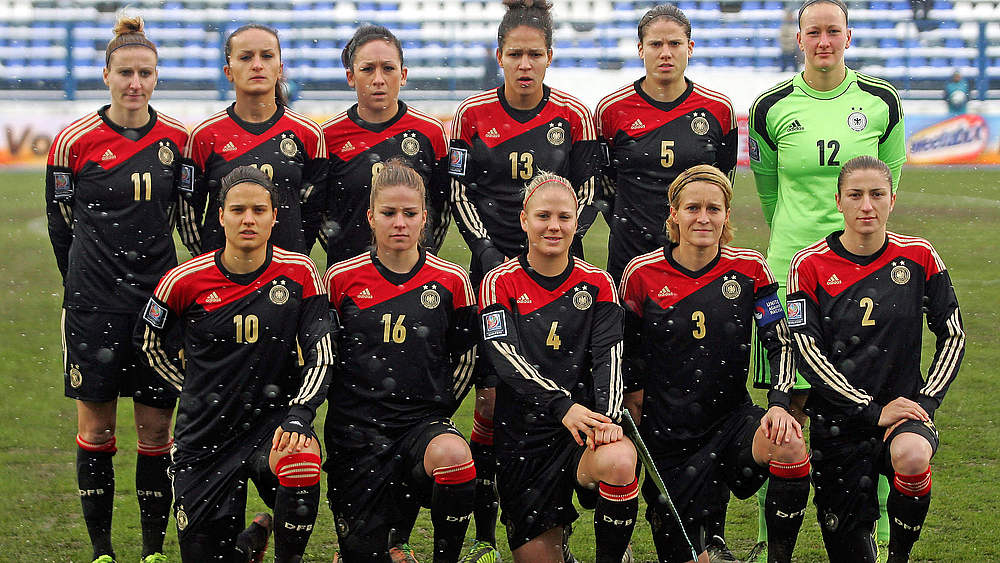The Germany women’s national soccer team (German: Deutsche Fußballnationalmannschaft der Frauen) represents Germany in international women’s soccer. The team is governed by the German Football Federation (DFB).
Here in this article, you will get to know about Germany Women’s National Football Team 2022/23 Players, Squad, History, Stadium, Nickname, Kits, and more.
Germany Women’s National Football Team Profile Summary
| Nickname(s) | DFB-Frauenteam (DFB Women’s Team) DFB-Frauen (DFB Women) |
|---|---|
| Association | Deutscher Fußball-Bund (DFB) |
| Confederation | UEFA |
| Head coach | Martina Voss-Tecklenburg |
| Captain | Alexandra Popp |
| Most caps | Birgit Prinz (214) |
| Top scorer | Birgit Prinz (128) |
| FIFA code | GER |
About Germany Women’s National Football Team
The German women’s national soccer team (German: Deutsche Fußballnationalmannschaft der Frauen) represents Germany in international women’s soccer. The team is governed by the German Football Federation (DFB).
The German team is one of the most successful in women’s football. They are two-time world champions, having won the 2003 and 2007 tournaments. The team have won eight of the thirteen UEFA European Championships, clinching six consecutive titles between 1995 and 2013. They, along with the Netherlands, are one of the two nations that have won both the women’s and men’s European tournaments.
Germany won Olympic gold in 2016, after three consecutive bronze medals at the Women’s Olympic Football Tournament, finishing third in 2000, 2004, and 2008. Birgit Prinz holds the record for most appearances and is the all-time leading goalscorer of the team. Prinz has also set international records; she has received the FIFA World Player of the Year award three times and is the second joint top scorer at the Women’s World Cup.
Germany Women’s National Football Team History
Early History
In 1955, the DFB decided to ban women’s football at all its West German clubs. In its explanation, the DFB cited that “this combat sport is fundamentally alien to the nature of women” and that “body and soul would inevitably suffer damage.” Furthermore, the “display of the body violates etiquette and decency.” Despite this ban, more than 150 unofficial international matches were played in the 1950s and 1960s. On October 30, 1970, the ban on women’s football was lifted at the annual DFB convention.
1982-1994: Difficult beginnings and first European titles
In September 1982, Bisanz organized two scout training courses from which he selected a squad of 16 players. The team’s first international match took place on November 10, 1982 in Koblenz. Following the tradition of the men’s team, Switzerland was chosen as West Germany’s first opponent. Doris Kresimon scored the first international goal in the 25th minute. In the second half, 18-year-old Silvia Neid contributed two goals in a 5-1 win; Neid later became an assistant coach in 1996 and a head coach in 2005.
With five draws and one loss, West Germany failed to qualify for the inaugural 1984 European Championship, finishing third in the qualifying group. At first, Bisanz’s main goal was to close the gap with the Scandinavian countries and Italy, then the strongest teams in Europe. He emphasized basic skills training and the need for an effective youth program. Starting in 1985, Bisanz increasingly called on younger players, but initially had little success with this concept, as West Germany again failed to qualify for the 1987 European Championship final.
2003–present: Two consecutive World Cup titles
At the 2003 Women’s World Cup in the United States, Germany was drawn into a group with Canada, Japan, and Argentina. After winning all three group games, the German team defeated Russia 7-1 in the quarterfinals, setting up another showdown with the United States. Germany’s Kerstin Garefrekes scored after 15 minutes and goalkeeper Silke Rottenberg made several key saves.
In the dying minutes of the semi-final, Maren Meinert and Birgit Prinz sealed the 3-0 victory. On October 12, 2003, Germany faced Sweden in the World Cup final in Los Angeles. The Scandinavians took the lead before the break, but Maren Meinert equalized shortly after the break. The match went into extra time, where Nia Künzer headed the game-winning golden goal in the 98th minute to claim Germany’s first Women’s World Cup title. Birgit Prinz was awarded as the best player and top scorer of the tournament.
With victories over China and Mexico, the German team finished first in their group at the 2004 Summer Olympics. They beat Nigeria 2-1 in the quarterfinals but suffered a 1-2 loss in the semifinals to the United States. after the extension. In the match for third place, Germany defeated Sweden 1–0 on a goal by Renate Lingor, earning the team’s second Olympic bronze medal.
Germany Women’s National Football Team 2022/2023 players Squad?
| GOALKEEPER | POS | AGE | HT | WT |
|---|---|---|---|---|
| Ann Katrin Berger | G | 32 | 5’10” | 138 lbs |
| Merle Frohms | G | 28 | 5’8″ | 132 lbs |
| Maria Luisa Grohs | G | 21 | 5’10” | – |
| Stina Johannes | G | 23 | 5’9″ | – |
| Almuth Schult | G | 32 | 5’10” | 160 lbs |
| DEFENDER | POS | AGE | HT | WT |
|---|---|---|---|---|
| Sara Doorsoun-Khajeh | D | 31 | 5’6″ | 127 lbs |
| Alicia-Sophie Gudorf | D | 21 | – | – |
| Kathrin Hendrich | D | 30 | 5’8″ | 121 lbs |
| Sophia Kleinherne | D | 22 | 5’6″ | – |
| Carolin Simon | D | 30 | 5’4″ | 119 lbs |
| Marie Joelle Wedemeyer | D | 26 | 5’6″ | – |
| MIDFIELDER | POS | AGE | HT | WT |
|---|---|---|---|---|
| Linda Dallmann | M | 28 | 5’2″ | 114 lbs |
| Jana Feldkamp | M | 24 | 5’6″ | – |
| Chantal Hagel | M | 24 | – | – |
| Svenja Huth | M | 32 | 5’4″ | 119 lbs |
| Lena Lattwein | M | 23 | 5’9″ | – |
| Lina Magull | M | 28 | 5’5″ | 119 lbs |
| Janina Minge | M | 23 | 5’6″ | – |
| Sjoeke Nusken | M | 22 | 5’8″ | – |
| Maximiliane Rall | M | 29 | 5’10” | – |
| Felicitas Rauch | M | 26 | 5’5″ | – |
| Elisa Senss | M | 25 | – | – |
| FORWARD | POS | AGE | HT | WT |
|---|---|---|---|---|
| Etonam Nicole Anyomi | F | 23 | 5’6″ | – |
| Jule Brand | F | 20 | – | – |
| Klara Buehl | F | 22 | 5’7″ | – |
| Laura Freigang | F | 25 | 5’7″ | – |
| Melissa Kossler | F | 22 | – | – |
| Paulina Kate Krumbiegel | F | 22 | – | – |
| Lena Oberdorf | F | 21 | 5’8″ | – |
| Alexandra Popp | F | 31 | 5’8″ | 149 lbs |
Germany Women’s National Football Team Home Stadium
The German soccer team does not have a national stadium. Like the men, the women’s team plays its home games in different stadiums throughout the country. Until June 2011, they played in 87 different German cities. The majority of home games have been in Osnabrück with six games, followed by Ulm (five games) and Bochum, Kaiserslautern, Koblenz, Lüdenscheid, Rheine, Siegen and Weil am Rhein (three games each). The first home game in former East Germany was played in Aue in May 1991.

Germany Women’s National Football Team Kit
The German women’s soccer team wears white jerseys with black shorts and white socks, following the tradition of the German men’s national team: black and white are the colors of Prussia. The current swap kit is all dark green. In the past, Germany has also used green jerseys with white shorts and green socks as their away kit, as well as a red and black kit, with black shorts and red socks.

Kit sponsorship
Adidas
Germany Women’s National Football Team world rankings
| Current | 2 1 (9 December 2022) |
|---|---|
| Highest | 1 (October 2003 – 2007, December 2014 – June 2015, March 2017) |
| Lowest | 5 (June 2022) |
Germany Women’s National Football Team trophies
FIFA Women’s World Cup
- Champions: 2003, 2007
- Runners-up: 1995
- Fourth place: 1991, 2015
Conclusion
This article was all about Germany Women’s National Football Team and much more. Share your thoughts in the comment section.
Source: FootballArroyo.co.uk

